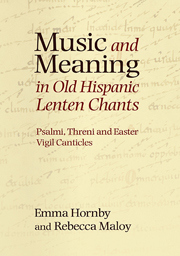Book contents
- Frontmatter
- Contents
- List of Music Examples
- List of Figures
- List of Tables
- Preface
- Abbreviations
- Manuscript Sigla
- Introduction
- CHAPTER 1 Thematic Congruity in the Old Hispanic Lenten Liturgies
- CHAPTER 2 The Threni
- CHAPTER 3 Melodic Language in the Old Hispanic Lenten Psalmi
- CHAPTER 4 Words and Music in the Psalmi
- 5 The Easter Vigil Canticles
- Afterword: Some Thoughts on the Relationship between the Old Hispanic Traditions A and B
- APPENDIX 1 A Guide to Reading Old Hispanic Notation
- APPENDIX 2 The Threni Texts
- Bibliography
- Index of Manuscripts Cited
- Index of Chants Cited
- Index of Scholars Cited
- General Index
- Studies in Medieval and Renaissance Music
CHAPTER 1 - Thematic Congruity in the Old Hispanic Lenten Liturgies
Published online by Cambridge University Press: 05 December 2013
- Frontmatter
- Contents
- List of Music Examples
- List of Figures
- List of Tables
- Preface
- Abbreviations
- Manuscript Sigla
- Introduction
- CHAPTER 1 Thematic Congruity in the Old Hispanic Lenten Liturgies
- CHAPTER 2 The Threni
- CHAPTER 3 Melodic Language in the Old Hispanic Lenten Psalmi
- CHAPTER 4 Words and Music in the Psalmi
- 5 The Easter Vigil Canticles
- Afterword: Some Thoughts on the Relationship between the Old Hispanic Traditions A and B
- APPENDIX 1 A Guide to Reading Old Hispanic Notation
- APPENDIX 2 The Threni Texts
- Bibliography
- Index of Manuscripts Cited
- Index of Chants Cited
- Index of Scholars Cited
- General Index
- Studies in Medieval and Renaissance Music
Summary
Chants acquire meaning through the rituals in which they are sung and their juxtaposition with the texts and music that surround them in the liturgy. The psalmi and threni, the primary Lenten focus of this book, can be most richly understood not in the isolation of their respective genres, but within their wider liturgical and intellectual context. The psalmi and threni participate in the recurrence of certain key words and ideas during the Lenten season. The primary theological themes of the Old Hispanic Lenten liturgy, as articulated in its readings, prayers and chants, form a tapestry into which the psalmi and threni are seamlessly woven.
The Old Hispanic Lenten Mass and Office chants are based on carefully chosen biblical sources, which are sometimes altered to reflect specific themes such as fasting, sin, repentance, and persecution. These chants resonate with exegetical concepts familiar to early medieval clerics and monastics through the writings of Augustine of Hippo, Isidore of Seville, Gregory the Great, and others. Further, several genres of Old Hispanic chant, including the threni and psalmi, seem to have been organized in series, sometimes numerically (for example, a set of chants with psalmic texts, arranged liturgically in ascending order), and sometimes thematically.
- Type
- Chapter
- Information
- Music and Meaning in Old Hispanic Lenten ChantsPsalmi, Threni and the Easter Vigil Canticles, pp. 28 - 74Publisher: Boydell & BrewerPrint publication year: 2013

